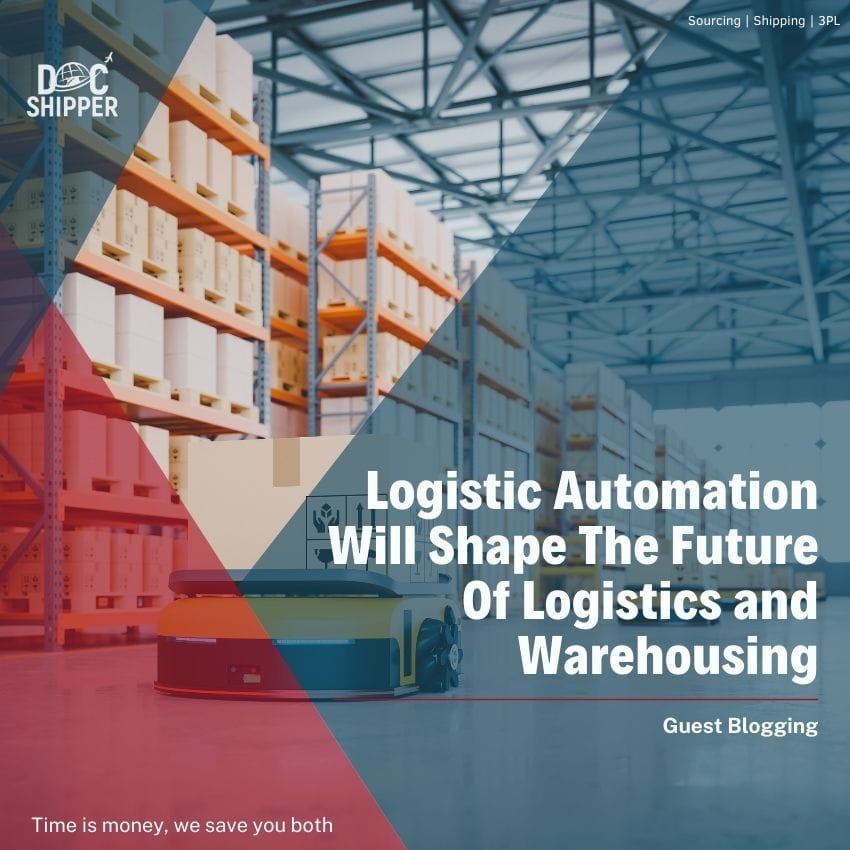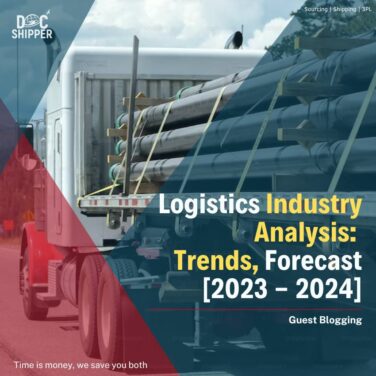In logistics, automation or automatic control refers to the use of control systems, machinery, or software to increase operational efficiency. It usually refers to processes that must be carried out at a warehouse or distribution centre with the least amount of human intervention possible. In fact, there are numerous procedures that could be automated along the supply chain (procurement, distribution, customer support, reverse logistics, etc.). According to Reports and Data, the logistics automation market has been growing significantly. Growing from USD 52.59 Billion in 2020, the logistics automation market is expected to register a CAGR of 12.4% to reach USD 133.21 Billion in 2028. Robotic arms, automated guided vehicles (AGVs), and software are all examples of logistics automation. This technology combines to make warehouse procedures more efficient, safe, and precise. What was previously unthinkable in warehouses has now become not only conceivable, but also profitable, thanks to modern automation.
Material handling and logistics automation are inextricably linked. To increase efficiency and accuracy, automated processes and technology are used to supplement the personnel. These technologies can include, among others, the following:
- Automated guided vehicles (AGVs) that transport totes and pallets
- Warehouse-specific robotic arms that grasp, move, palletize, depalletize, and sort totes
- Advanced automated storage/retrieval systems (AS/RSs) with the ability to store products in racks
From the first mechanical pallet conveyors to the most recent lights-out facilities, the logistics business has always been ripe for automation. However, today’s most sophisticated logistics automation technologies can be found in the cloud rather than on the warehouse floor. Automation technologies such as Robotic Process Automation (RPA) bots, Intelligent Document Processing (IDP) systems, and full hyper-automation platforms that orchestrate end-to-end processes involving both software and human workers are helping logistics managers eliminate operation-wide inefficiencies.
Logistics management used to be done on paper. Orders, bills of lading, and invoices were typed and passed back and forth by shippers. It was sluggish and prone to errors. In the 1970s, as computing began to take off in the industry, Electronic Data Interfaces (EDIs) were developed to share transportation data, allowing carriers to execute their first track-and-trace programs. Later, same carriers began to share such information with their customers, ushering in the present era of delivery notifications and tracking numbers included with every order.
Logistics automation tools began to face more complicated problems with the introduction of artificial intelligence. Today, AI-enabled automation solutions are automating logistical processes ranging from document verification to order tracking to predictive modelling.
Some of the Benefits Of Logistics Automation Includes
Automation Provides A Complete Picture Of Current Rates
Shippers have found automation to be a boon because it allows them to get transparent shipping prices from several logistics companies. The procedure also includes information on the mode of transportation. It makes it much easier for merchants to make logistics decisions. This method aids in the reduction of corporate costs while also providing an estimate of monthly expenses.
Automation Assists in Improving Customer Service
Every piece of information is now recorded in a computer, which can be accessed whenever needed thanks to automation. As a result, there
is less uncertainty about overall logistics management. There are also fewer concerns about human error.
Losing a customer in an e-commerce business is extremely inconvenient for both retailers and transportation companies. Automation not only makes office jobs easier, but it also helps with front-line customer service. Customers are becoming satisfied and regaining trust in e-commerce and logistics as a result of receiving a transparent cost estimate and good service.
Reports Are More Easily Accessible Thanks To Automation
Accessing reports and keeping track of all of the company’s data is also easier with automation. During an audit or computation, it also makes it easy to get the facts and figures properly. They also allow these companies to better analyse their growth trajectory and performance. This allows them to concentrate on making the necessary adjustments.
Automation Aids Scalability
Automation has given rise to a slew of useful technologies for the logistics and transportation industries. It has not only allowed many firms to flourish, but it has also lowered the amount of work they have to do on a daily basis.
Even if some organisations are still using old school work procedures, others are combining their current process with the new one, resulting in a semi-automated way. When used correctly, automation has a lot of advantages to offer. They’re scalable, and they cut down on human work. Logistics is one of the fastest-growing industries, with plenty of room for expansion with the right automation in place.
Automation Aids in the Proper Integration of Logistics
Along with assisting back-end labour routines, automation also helps with order fulfilment and distribution. They’ve come to make the logistics industry as a whole more efficient and to lower overall company costs. By automating the supply chain, the logistics director can concentrate on improving the overall process rather than becoming bogged down in one aspect. Solutions like warehouse management systems and robotics can be easily taken care of which will helps to boost productivity and build a stronger platform.
Automation Aids In The Achievement Of Distribution Goals
Logistics supported by automation solutions are able to reach their distribution goals significantly more quickly by integrating various AI-driven technology and cloud-based solutions. Not only that, but they’ve been able to expand their reach and deliver happiness to people all around the world.
Challenges in Logistical Automation Include
The potential of automation intrigues logistics organizations, but they should be mindful of the hazards of automation as well. As a result, they are investing cautiously. Though consumers of logistics companies and automation in retail, automotive and medicines is increasing rapidly, investment in logistics automation is expected to grow at the slowest rate in logistics, at around 3% to 5% per year through 2028.

DocShipper info
DocShipper info : If you want any information regarding the logistics and warehousing, contact our experts, they will answer all of your questions
Competition In Capturing E-Commerce Clients
Any logistics company that wants to take advantage of the massive e-commerce growth opportunity must meet two basic requirements: speed and diversity. For instance, in same-day shipping on any of a million SKUs, more automation in picking, packing, and sorting appears to be an obvious investment decision to cope with this. However, many logistics companies are held back by the peculiar relationships that exist between logistics providers and e-commerce customers. The danger can appear in a variety of ways. E-commerce businesses have higher purchasing power; they can easily switch to a competitor if they don’t like a logistics company’s offer. This tends to keep prices low, and it may prevent logistics companies from getting a good return on a large automation investment.

Serving e-commerce enterprises presents a unique problem in that demand is extremely erratic, easily doubling during Christmas or Singles’ Day. Alibaba’s logistics arm, Cainiao, processed 812 million orders on Singles’ Day 2017, eight times higher than on a regular day. For three-quarters of the year, logistics companies will need significant spare capacity to meet customer expectations during peak periods. E-commerce behemoths will have even more incentive to build their own capabilities if they do not construct enough capacity for peaks, like Amazon did following the 2013 Christmas season.
Technology Is Advancing at Breakneck Speed
Technologies for logistics automation are available aplenty but these technologies are advancing at such a speed that some are becoming obsolete as soon as they are marketed. No one wants to invest in technology that will become obsolete soon after purchase. Not only would this make a company less efficient than competitors who made better decisions, but it would also put it at a disadvantage against competitors who made no investment at all. The cost of removing and replacing equipment, much of which has not yet depreciated, would sink unlucky investors.
Purchasing Difficulties
Even if a logistics company buys the best automation equipment available, it may run across another issue. the biggest warehouse-automation manufacturers have had substantial sales growth of 15 to 20% each year. Many order books are now completely full. Vanderlande Industries’ order book hit an all-time high in 2017. Part of the issue is that the manufacturers are still working at a small scale. Many businesses, including industry leaders, are narrowly focused on a few technologies and solutions. That could change: the industry is in turmoil, with a lot of mergers and acquisitions going on. Large technology corporations, in particular, are investing in automation start-ups.
Distribution Networks of Shippers Are Rapidly Changing
Part of how brick-and-mortar businesses are responding to the e-commerce onslaught is by transforming their distribution networks into omnichannel systems, which allow customers to buy and receive things via any channel. They could shop online and have their purchases delivered to their homes, as is the traditional e-commerce strategy. They may increasingly order online and pick up in stores. Alternatively, people might shop in-store and have their orders delivered to their homes, as menswear firm Bonobos and others do. They can still go to the store and leave with their items, of course. Furthermore, customers are demanding speedier delivery, which necessitates more local storage capacity, adding to the complexity. It’s difficult to build a supply chain that can support an omnichannel system.
DocShipper Advice
DocShipper Advice : You are looking for some transportation advices ? Contact our team, they will answer all of your requires
5 Logistics Automation Trends to Follow
The logistics automation sector is fast-paced, making it difficult to stay up with all of the latest developments. Here are five key logistics automation developments to keep an eye on in the near future.
Identifying automation potential through process mining
Automating an inefficient process can only make it worse. Managers can receive a true picture of how a work is done, step by step, by using process mining tools. You can uncover inefficient phases at the keystroke level by thoroughly mapping the process. Those are the jobs that should be automated using RPA.
The use of robotic process automation (RPA) in logistics call centers is growing
Call center employees are in charge of organizing dock-door schedules, incoming and exiting shipments, and warehouse movement. Data must be entered and validated by warehouse staff. From moving data between systems to logging into supplier portals to updating clients, there are a lot of moving pieces, and navigating them demands a lot of repetitive keystrokes. RPA can automate these processes, decreasing keystrokes, re-keying, rework, and other inefficiencies in call centers.
ERP and intelligent automation cockpit integration
Front-line logistics employees can benefit greatly from intelligent automation. One of the main ways it does this is by offering a single interface, which acts as a user cockpit for the various software systems they must navigate. The logistics cockpit combines artificial intelligence (AI) assessments of various data for a warehouse with video footage from cameras positioned in the warehouse. The cockpit presents the combined data in an easy-to-understand format to assist on-site decision-making.
Customer and supplier portals with digitally automated operations
Web portals have become an industry standard for logistics professionals who spend a lot of time navigating through customer and supplier portals. RPA can automate numerous repetitive operations related with these portals, whether they be inbound or outbound orders.
Optimization of multimodal transportation
In the shipping industry, there are numerous elements to consider. One day, a shipper may find better rates by railing half the distance and then combining orders to fill a full truckload. A few less-than-load carriers may offer a better deal the next week. Multimodal shipping combines these diverse forms of transportation to determine the best route in terms of both on-time delivery and cost. Combinatory optimizers are automation systems that take all variables into consideration to design the most effective carriers and shipping paths available, and they frequently use machine learning to improve over time.
FAQ | Logistic Automation Will Shape The Future Of Logistics and Warehousing
In logistics, automation or automatic control refers to the use of control systems, machinery, or software to increase operational efficiency. It usually refers to processes that must be carried out at a warehouse or distribution centre with the least amount of human intervention possible. There are numerous procedures that could be automated in the supply chain such as procurement, distribution, customer support, reverse logistics, etc.
According to Reports and Data, the logistics automation market has been growing significantly. Growing from USD 52.59 Billion in 2020, the logistics automation market is expected to register a CAGR of 12.4% to reach USD 133.21 Billion in 2028.
Advantages of logistics Automation includes improved customer service, ease in accessing current rates, scalability, easy access to reports, proper integration of logistics and more efficient achievement of distribution goals.
Competition in capturing e-commerce clients, ever changing automation technology, difficulties in deciding which technologies to purchase and changing networks of shippers are challenges that are faced by logistics automation implementation.
Current trends to follow in logistics automation include: - Identifying automation potential through process mining - The use of robotic process automation (RPA) in logistics call centers is growing ERP and intelligent automation cockpit integration - Customer and supplier portals with digitally automated operations - Optimization of multimodal transportation

About the Author
Paroma Bhattacharya
Paroma Bhattacharya has dabbled in the realm of content production for over half a decade and possesses extensive experience in penning down pieces related to healthcare, technology, banking, and a wide range of other industry verticals. Her articles focus primarily on balancing relevant data while never neglecting to make the material engaging. She believes in providing objective facts to help people make important business decisions.
Contact: +1-212-710-1370
Read More
Looking for more? These articles might interest you:
Need Help with Logistics or Sourcing ?
First, we secure the right products from the right suppliers at the right price by managing the sourcing process from start to finish. Then, we simplify your shipping experience - from pickup to final delivery - ensuring any product, anywhere, is delivered at highly competitive prices.


Fill the Form
Prefer email? Send us your inquiry, and we’ll get back to you as soon as possible.
Contact us






